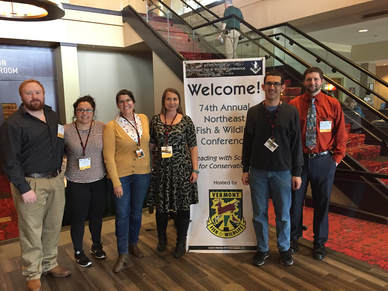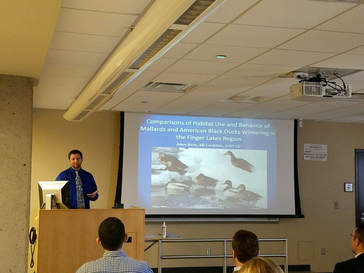 From left: Justin Droke, Sam Mello, Amanda Cheeseman, Alison Kocek, Jonathan Cohen, Adam Bleau
From left: Justin Droke, Sam Mello, Amanda Cheeseman, Alison Kocek, Jonathan Cohen, Adam Bleau Braving an early spring blast of ice and snow, members of the Cohen Lab traveled to Burlington, VT this week to present their work at the Northeast Association of Fish and Wildlife Agencies annual conference. On our first afternoon, post-doc Amanda Cheeseman co-moderated a symposium on current scientific knowns and unknowns in the ecology and conservation of the New England cottontail, which she organized with our collaborator Dr. Adrienne Kovach of the University of New Hampshire. The New England cottontail is a critically imperiled rabbit native to the northeastern U.S. that faces numerous threats discussed by the symposium speakers. Dr. Kovach began by summarizing our current knowledge on the species population structure, and Amanda presented her Ph.D. work on habitat selection and competition with non-native eastern cottontails. Samantha Mello spoke about her Master's work on parasites of the two species, and other talks focused on captive breeding and release efforts, rangewide disease and parasite studies, population viability and response to management, and the multi-state collaborative monitoring effort for the species. The symposium represented the first time that researchers from all the Universities studying the New England cottontail organized a scientific meeting to synthesize their work, including SUNY-ESF, the University of New Hampshire, the University of Rhode Island, Brown University, and the University of Connecticut. In a concurrent session that afternoon, Dr. Cohen presented the work of Ph.D. student Michelle Stantial on the application of miniaturized GPS tags for tracking piping plovers during the breeding season. Michelle has demonstrated that high-resolution habitat use information for this threatened species can safely be obtained using these 1-gram transmitters.
The Cohen lab's bird projects took the stage for the second day of the conference, beginning with Justin Droke's presentation of his Master's work on spring staging interaction between American black ducks and mallards, followed by Adam Bleau's parallel work on competition between these two species in the winter. Black ducks, native to the northeastern U.S., saw sharp population declines in the 20th century, and the closely-related mallard expanded rapidly into their range. There have been several hypotheses to explain the black duck decline, and Justin and Adam's work focuses on the role of competition with mallards in the nonbreeding part of the annual cycle. Alison Kocek gave our final talk of the conference, unveiling her results on the use of PIT tags attached to legbands to greatly reduce capture and handling of birds in tidal marshes, while at the same time greatly increasing the rate of identification of individual nesting birds compared to repeat captures. Her work focuses on

 RSS Feed
RSS Feed
